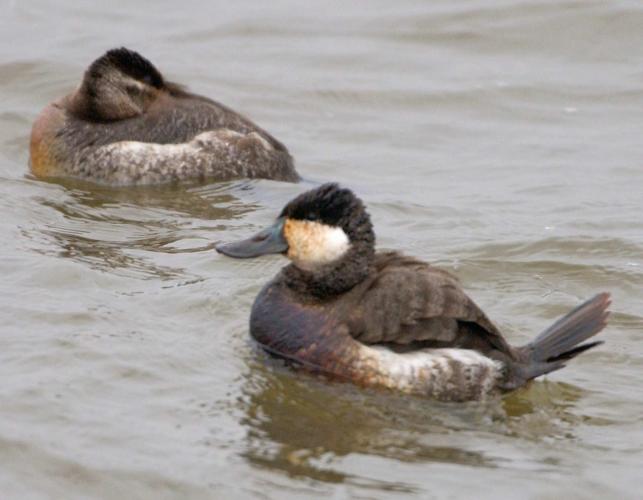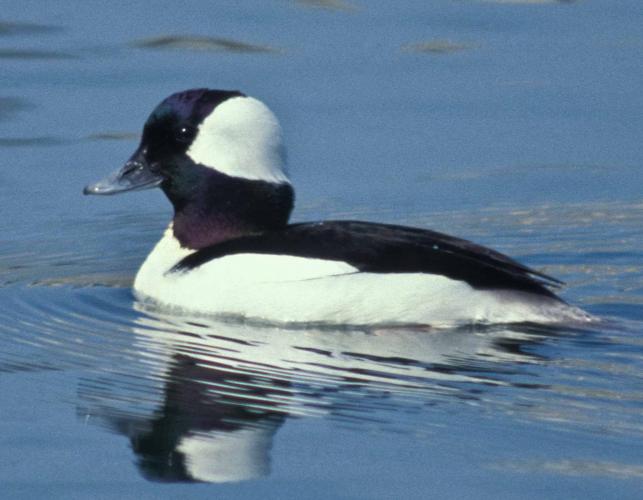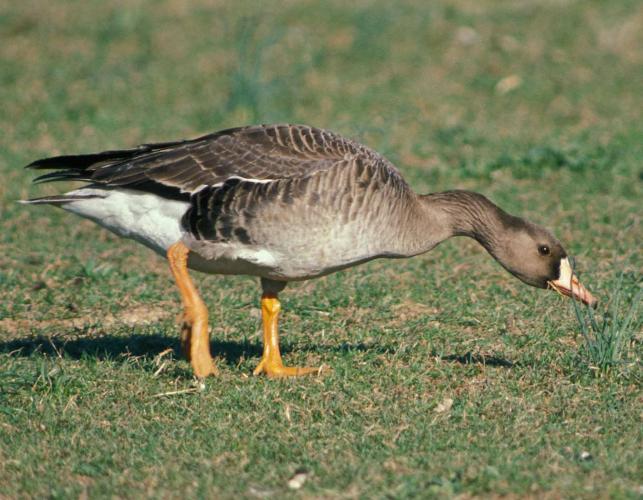Browse Missouri's wildlife restoration success stories, including the American burying beetle, deer, elk and wild turkey.
Many species of waterfowl spend at least part of their lives in the wetlands of Missouri.
Most duck species nest elsewhere and migrate through Missouri in fall and winter, but several species of dabbling ducks (mallards and blue-winged teal, for example) nest here in rather low numbers. The wood duck and hooded merganser, both cavity nesters, are regular nesters in Missouri.
Of the geese species, only the Canada goose nests with any regularity in Missouri.

Ducks are divided into dabbling and diving ducks according to their habits and the habitats they use.
Diving ducks use larger, deeper, more open bodies of water than dabblers. There really is little that managers can do to improve diver habitat.
Dabbling ducks prefer feeding in shallow water and can fly directly off the water. They are attracted to herbaceous and timbered wetlands. Follow these steps to properly manage wetlands on your property for dabblers.
Title
Herbaceous Wetlands
Missouri has several types of herbaceous (soft-stemmed, non-woody plant) wetlands. These include emergent marsh, wet prairie, fens, and moist-soil areas. Of these, emergent marsh and moist-soil areas offer the most benefit to ducks. These habitats consist of rooted vegetation that grows up out of the water. In some cases, the plants tolerate flooding and grow even in standing water. In others, the manager must regulate water levels to allow the plants to germinate and/or grow in non-flooded conditions, then flood the vegetation in the fall after the plants decline.
Emergent marsh
This habitat type generally consists of flood-tolerant, perennial, rooted vegetation growing in semi-permanent water. Emergent marsh provides important habitat for dozens of wildlife species, but long-standing water prevents annual plant seeds from germinating and growing with any regularity. Therefore, these areas tend to be more important to ducks for roosting rather than for feeding.
Examples of emergent marsh include:
- cattail sloughs
- abandoned river channels
- shallow ponds
- permanently saturated, ephemeral pools with stands of bulrush or other tall plants
Moist-soil areas
An often overlooked way to attract ducks is to manage the wetland pool for robust stands of native annual plants. These include annual smartweeds and wild millets, which produce heavy amounts of seed. Annually disk, or otherwise disturb, roughly one-third of the wetlands. These areas are rotated on three-year cycles. The disking creates favorable conditions for seeds to germinate, thereby making these areas the most productive following the next year’s spring drawdown. Following disking, manage water levels to shallowly flood or saturate the soil, then draw the water down slowly. Pools managed this way can produce tremendous volumes of seed, which can then be flooded to attract ducks during fall migration. Moist-soil seeds are used heavily in the early half of the duck season.
Flooded crops
Flooded crop management is similar to managing moist-soil wild plants. Corn is the most commonly planted flooded crop, but it is also the most costly. Milo is another option, but large flocks of blackbirds often rob most of the seed before the ducks can use it. Japanese millet, buckwheat, and rice are other options, but not all plants will tolerate shallow flooding during the growing season. Floods of more than a few days will often kill most crops. Keep in mind that grain is a high-energy food source, but ducks may not use it very heavily until the latter half of the season.
Title
Timbered Wetlands
At the time of European settlement, Missouri had thousands of acres of wooded wetlands. Cypress swamps, sloughs, and oxbow lakes covered most of the Bootheel region, and large rivers such as the Osage, Grand, and Missouri had vast acres of bottomland hardwoods, swamps, and sloughs. Today, most of these acres have been lost through draining and clearing to make way for row crops. Timbered wetlands still do exist, and landowners who own them can often manage their property to enhance the health and utility of these habitats.
An important aspect of managing timbered wetlands is knowing when and how long to hold water. Managing these areas for duck use typically means flooding the timber with several inches of water to make food accessible and attract birds looking for a place to rest and/or feed. Nearly all trees in Missouri can be killed or injured by flooding at the wrong time. If you have a timbered wetland pool (green-tree reservoir), it is vital that you only flood during times when the trees are dormant. Furthermore, most mast-producing bottomland trees such as pin oak will be healthier and live longer if they are not flooded every year.
Acorns are an important food for several duck species, so green-tree reservoirs are usually managed for oak trees and acorn production. However, managing flooded timber for duck use and long-term forest health is complicated. For more information, talk with an MDC forester or a wildlife biologist.
- acorns
- barnyard grass
- buttonbush
- coontail
- corn
- duck potato (also known as midwestern arrowhead and wapato)
- Japanese millet
- milo
- nutsedges
- pondweeds
- rice
- rice cutgrass
- sedges
- smartweeds
- toothcup
- waterhemp
- wheat
Wood ducks are cavity-nesting ducks, and they often choose a nest cavity high in a tree. They generally nest near a water body, but they will also nest hundreds of yards from water.
Landowners with sloughs, oxbows, creeks, and lakes on their property can help wood ducks by keeping some large den trees in their woods. Suitable natural cavities are often in short supply, so several well-placed nest boxes can boost the wood duck population in your area. Wood ducks readily take to man-made nest boxes.
Title
Nest Sites
Place artificial nest boxes in areas wood ducks frequent, but where natural nest sites no longer exist or are limited. Lakes and ponds containing or surrounded by standing timber are ideal locations for nest boxes.
A good wetland site for wood ducks should have three characteristics:
- Approximately half of the wetland should be open water, with the remainder in green plant cover.
- A supply of animal foods, such as insects and other invertebrates. These are critical, especially for ducklings less than four weeks old.
- Water that will remain until the ducklings are able to fly at eight to 10 weeks old.
Title
Construction
Download wood duck nest box plans from Audubon.
Nest boxes are commonly made from wood. When making a wood duck box remember:
- Make the entrance hole 4 inches wide for both circular and oval holes.
- Put hardware cloth beneath the entrance on the inside of the box so the ducklings can climb out.
- Put drain holes in the bottom of the box to prevent rain from flooding the eggs.
Title
Installation
Wood ducks will use boxes placed over or near water. Duckling survival is greater when the boxes are within one-half mile of water because they leave the nest and walk to the nearest body of water shortly after hatching. Face nest boxes toward the water.
To install a nest box over water, place it above the spring high-water mark. Wood ducks will use boxes regardless of height, so attach boxes to trees no higher than is convenient for maintenance. Mounting wood duck boxes on a pole over water also helps deter nest predators. Only a few boxes are necessary the first year. Add more boxes later, if the first ones are used.
Title
Maintenance
Repair all boxes, remove old nests, and add fresh material in the winter so that the boxes are ready for new nests by early March. Since wood ducks do not carry nesting materials to build their own nest, place 3–5 inches of wood shavings in the bottom. Avoid sawdust, because it often absorbs and holds moisture.
Check predator guards annually. The best way to keep predators from boxes on trees is to install metal bands at least 50 inches wide flush around the trunk. Protect boxes on posts from predators by using an inverted metal cone below the box. Make sure you remove overhanging limbs that are close to the box. Black snakes and raccoons can use these overhanging limbs to approach nest boxes.
Three species of goose are regularly seen in Missouri:
- Canada goose
- Greater white-fronted goose (also known as specklebellies)
- Snow goose (blue and white color phases)
Only the Canada goose breeds with any regularity in the state; the other two species are migrants.
Title
Food Needs
All species of geese in Missouri feed primarily in agricultural fields in fall and winter. Feeding locations shift frequently as geese respond to food availability and depletion, hunting pressure, and weather conditions. Feeding fields tend to be relatively large, and all species of geese are generally reluctant to land and feed in fields smaller than 10–20 acres if the perimeter is wooded or brushy.
Winter foods consist of waste grain, especially corn, and green forage such as wheat or rye. To attract geese in winter, avoid fall tillage of grain stubble, especially corn and milo, which buries a good amount of potential food. Little else can be done to enhance winter food production and availability for geese.
Consider frequent mowing of lake and pond edges to attract Canada geese during the breeding season. Canada geese are much more likely to use a pond or lake when the shoreline vegetation is kept short. This condition facilitates their feeding on tender new plant growth and reduces predation risk by affording them good visibility. Canada geese readily feed on common turf grasses such as bluegrass and even tall fescue if the grasses are kept mowed. Plant other preferred foods such as wheat, oats, rye, clover, and alfalfa right up to the water’s edge.
- alfalfa
- bluegrass
- clovers
- corn
- milo
- nutsedges
- oats
- rice
- rye
- smartweeds
- soybeans
- spike rushes
- wheat



































